Is that the promise of summer in the air? With warmer temperatures approaching, I’m sure all you can think about is getting back on the banks.
But how can a beginner become a part of the carp fishing scene without any prior experience? Well, this full carp fishing guide can be a big help in that department. This post is a short summary of all the things you can find in “Guaranteed Carp: The Comprehensive Carp Fishing Guide”.
Introduction To Carp Fishing
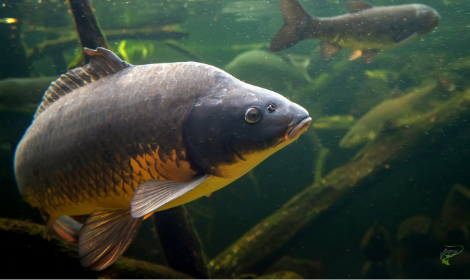
Carp Fishing is a massive sport across the UK and elsewhere in many parts of the world. Anglers love catching carp because they can grow to massive sizes and fight ferociously once hooked. Most anglers love the challenge and the ways in which you can outsmart the fish and get them to bite.
That being said, what do we truly know about carp? While many people may not know this, carp are actually not new to the area. In the 15th century, a couple of monks domesticated the carp and brought them to the UK to use them as a food source. However, it wasn’t until the 19th century that carp were imported to the UK to be fished for sport.
Over time, more European carp began arriving in the UK and their rapid proliferation began. Since these fishes grow to such large sizes and expel so many eggs every season, they provide a nutrient source for the other fish species in British waters.
It’s important that one is able to identify the different coarse fish species that commonly inhabit English waters. From common carp to bream, there’s no shortage of different coarse fish that newbies can learn about. While it may seem like hard work, being able to differentiate between two similar-looking fish species is the mark of a great angler.
So, if you’ve caught a bronze-grey fish with a large, downturned mouth and a deep body, there’s a good chance that it’s a common carp. A rounder fish with irregularly-arranged scales might be a mirror carp. A slimy fish with a tall physique and silver-grey scales might be a bream, while a small fish with a grey-green body and small spots on the side might be a gudgeon. This is only a small taster of the types of carp and coarse fish you will come across.
For a complete rundown on different coarse fish characteristics and how you can identify them, pick up “Guaranteed Carp: The Comprehensive Carp Fishing Guide”.
Carp Behaviours
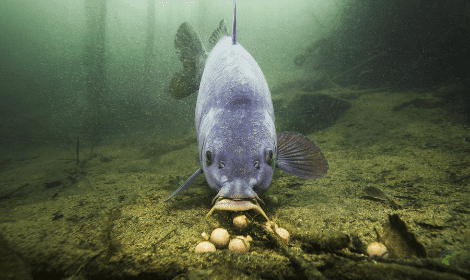
Just knowing how to tie a hair rig isn’t enough to become a good angler. There are several other things one must know to succeed out on the water, and one of those things is analysing carp behaviours.
Since carp are bottom feeders, they generally spend a lot of time near the bottom. But are they really bottom feeders? Generally, carp spend half their time feeding at the bottom, but they also spend the other half scavenging for food in all the other layers of the water. Hence, while their flat bellies and inferior mouth do indicate them to be bottom-feeders, carp also enjoy their food elsewhere in the water.
The next thing anglers need to be aware of is why carp jump. Generally, carp jump out when they want to recalibrate the pressures in their gills, especially when they’re on the move. However, if you see them poking their head out periodically in a silty area, there’s a good chance that they might be scavenging for food at the bottom and poking their heads out to clean their gills of the silt stuck in them.
However, when the carp jump to a very great height and the subsequent splashes are quite forceful, there’s a good chance that the carp are trying to rid their bodies of the various parasites stuck on them. That being said, if you see silt clouds and carp jumping in an area, it’s best to cast your line because there’s a good chance that a group of carp might be feeding there.
The next logical question here is, how do the carp feed? Well, here’s the helpful bit. Carp use nearly all of their senses to hunt for food but they mostly depend on their sense of sight and smell to find their next food source. So, if you truly want to attract the attention of the carp in your local fishing venue, a good idea might be to use brightly coloured baits such as corns or boilies and make sure they have strong smells. Chemical attractants might be a good idea in such a case!
You can find more information related to carp behaviours in “Guaranteed Carp: The Comprehensive Carp Fishing Guide”.
Carp Fishing Tackle
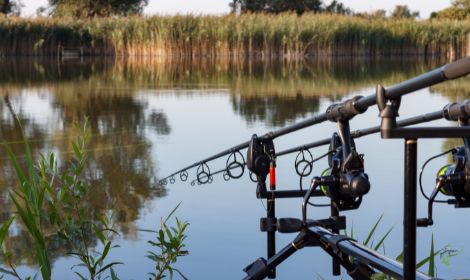
Another important aspect of carp fishing is deciding what tackle you’re going to use. If you’re confused about all the different specifications, don’t worry because this section deals with just that.
Rods have different specifications that you need to keep in mind, such as the rod length, the test curves and the rod action. There’s a huge range and different subtypes for each of these characteristics that you need to have some knowledge about before you buy your first rod. Keep in mind that most of these things generally depend on the type of fishing you’re going to be doing, so it is best to get some practice with someone else’s rod before buying your own.
Another important aspect of shopping for carp fishing tackle is knowing what kind of fishing you’re going to be doing. Feeder rods, spod rods and standard carp rods are some of the types that you’ll commonly encounter in your local tackle shop.
You should also pay attention to the reels you’ll use, what kind of line you’ll want to fish with and what end tackle you’ll need when fishing.
If you want to know more about the basics of tackle, read the chapter on carp fishing tackle in “Guaranteed Carp: The Comprehensive Carp Fishing Guide”.
Watercraft
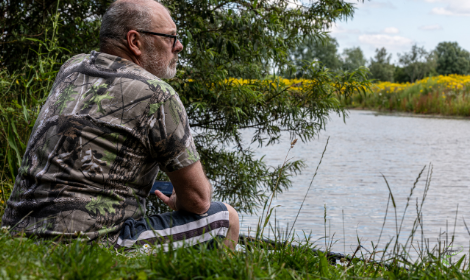
Watercraft is the art of analysing different carp behaviours and figuring out the best casting locations according to them. Anglers who practise watercraft get a lot of catches and generally have an excellent time out on the water because they know what they’re doing. Luckily, it’s not as hard as it sounds.
One of the first things you need to do is figure out when or where the carp are feeding. If you see mud clouds, startled birds nearby or carp jumping or rolling in a certain area of the river, there’s a good chance that the carp are feeding there. If you cast your bait in that spot, you’ll be near enough to guarantee a bite.
Another way to figure out a nice place to cast your line is to figure out the carp’s patrol routes. Carp are creatures of habit and generally frequent the same patrol routes every day. A little bit of observation and good eyesight will allow you to know where your carp head to every day and you can cast your line in these routes the next time you fish.
Learning the bottom composition of a lake or a river is also a critical part of watercraft. After all, how will you know how your bait presents if you don’t know what the bottom is like?
So, what else does watercraft consist of? The weather, of course! Most anglers look at the rain and think they cannot fish with PVA bags on their trip. However, there’s a lot bigger role that the weather plays in carp fishing, and an expert angler knows how.
Just to be clear, there are many aspects of the weather that affect carp activity. The main one is the temperature. Water temperatures rising or falling have a great effect on carp activity, as does the quality of the sky and whether it is clear or sunny. On the other hand, rain, fog, (some argue) the moon phases and air pressure also play a huge role in determining whether you will get any catches on the trip and wherein the water you might get them.
Watercraft is a very interesting aspect of carp fishing. For more information, read the full chapter on watercraft in “Guaranteed Carp: The Comprehensive Carp Fishing Guide”.
Baits

The baits we use for carp are numerous in quantity, and there are hundreds of different ways to prepare them, rig them and cast them. Not just that, but there are also several new baits on the market that provide great results when cast correctly.
In this section, we explore why it’s so important for anglers to know all about carp fishing baits and what conditions they should use them in. After all, you can’t fish bread in a lake with a duck population because the bait will never reach the carp. Similarly, you cannot fish a neutral-coloured boilie in a muddy lake because the carp have no visibility, which is why you’ll need a bright bait to catch their attention.
These days, anglers use a mixture of the classic baits from decades ago and newer baits that came about with technological advancements. These baits include sweetcorn, boilies, micropellets, maggots, bread, and other such things.
This section also discusses the pros and cons of each bait type. Maggots and their highly attractive smells are a great combination for fishing on a winter’s day when not much else is going on but doing so in a venue with lots of nuisance fish might pose a problem. In addition, an expert angler needs to know how to present the bait to make sure you make the most of the bait’s colour, taste, smell and shape.
Your baits determine how well you do. If you want to know more about the best baits for carp fishing, read the full chapter in “Guaranteed Carp: The Comprehensive Carp Fishing Guide”.
Rigs
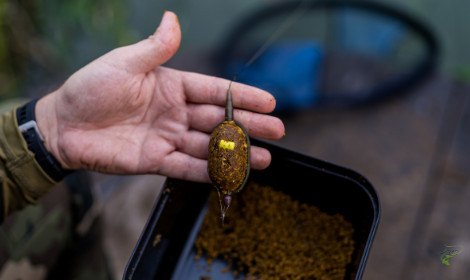
Now, this section is where newbie anglers need all the help they can get. The problem with rigs is that you need to learn how to tie them expertly to be useful on the water.
Take method feeder rigs, for example. It’s one of the simplest rigs on the market, but even that requires you to have a certain degree of skill to tie it. However, practice truly does make perfect, and you’ll soon know how you can deliver those neatly-packed mounds of delicious bait to the lake bottom.
Method feeders are excellent choices for when you need to present your bait in waters where the carp are quite suspicious and don’t engage with a lot of bait. The method feeder hides the hook in a small pile of bait, so the carp are none the wiser and end up biting straight into the hook.
The chod rig is excellent for when you are fishing in choddy waters. If you fish any regular rig in there, it’s going to get tangled or even break. The chod rig suspends itself above the weed so you don’t need to worry about your line getting tangled when you get a bite. The relative newcomer, the Ronnie rig, is also similar in action to the chod rig.
The PVA bag rig is another excellent presentation that you need to know all about before you begin your carp fishing career.
For more information on rigs, don’t forget to read the full chapter in the book “Guaranteed Carp: The Comprehensive Carp Fishing Guide”.
Carp Care

Carp care is one aspect of carp fishing that you won’t find much about online. That’s because most carp fishing blogs are more focused on how to catch fish than they are on how to release them. However, it is critical that you make sure to give the carp the least possible distress when handling it.
While carp can survive some time outside the water without dying, it is not good for them. So, make sure that you handle them carefully, not damage their slime coat, retrieve the hook as painlessly as possible, and release them gently into the water.
For more information on carp care, read the corresponding chapter in the book, “Guaranteed Carp: The Comprehensive Carp Fishing Guide”.
That’s All
Carp fishing is a fun pastime that you can take up any time you like. However, it’s important to learn all about the basics of carp fishing first and that’s what you will find in “Guaranteed Carp: The Comprehensive Carp Fishing Guide”. So, what are you waiting for? Read your copy now!

